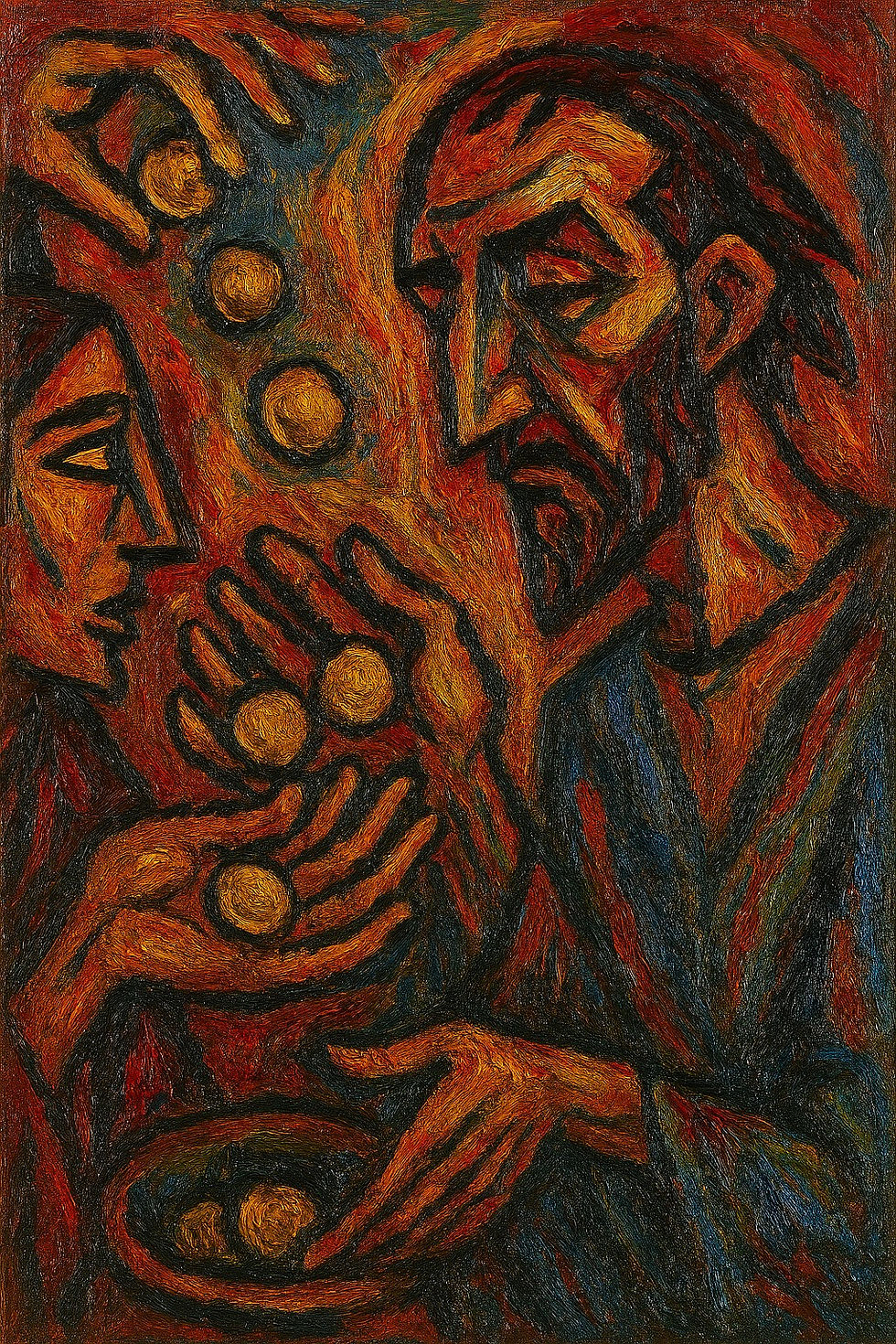Retinal signal transduction
- Martin Döhring

- 10. Okt.
- 4 Min. Lesezeit
Overview of Retinal Phototransduction
Retinal phototransduction is the process by which photoreceptor cells in the retina—primarily rods for low-light vision and cones for color and high-acuity vision—convert light into electrical signals. This occurs in the outer segments of these cells, where specialized photopigments embedded in the disc membranes capture photons. The core mechanism is a G-protein-coupled receptor (GPCR) cascade that leads to hyperpolarization of the photoreceptor membrane, reducing neurotransmitter release. While rods use rhodopsin as the primary pigment, cones employ three opsin variants (iodopsins) for wavelength specificity. The pathway amplifies a single photon's signal up to 100,000-fold, enabling high sensitivity, but includes rapid termination and adaptation for dynamic vision.

Light Absorption and Isomerization
Phototransduction initiates when a photon (wavelength 400–780 nm) is absorbed by the visual pigment, a seven-transmembrane opsin protein covalently bound to 11-cis-retinal (a vitamin A derivative) via a protonated Schiff base linkage between the retinal's C20 aldehyde and a lysine residue (Lys296 in bovine rhodopsin). In rods, the pigment is rhodopsin (absorption maximum ~500 nm, blue-green light), absorbing ~67% of incident photons due to its high quantum yield. In cones, three iodopsins handle color: erythrolabe (~565 nm, red), chlorolabe (~535 nm, green), and cyanolabe (~440 nm, blue), each with distinct opsin amino acid substitutions tuning spectral sensitivity.
Upon absorption, the photon's energy (~40 kcal/mol) excites an electron in the retinal, triggering a series of ultrafast conformational changes (within picoseconds to microseconds): the 11-cis isomer rotates around the C11=C12 double bond, forming all-trans-retinal. This "bleaching" disrupts the Schiff base, deprotonating it and shifting the opsin to its active Meta-II state (R*), a GPCR-like conformation with outward-facing TM6 helix. R* acts as the signaling switch, with a lifetime of ~40 seconds in rods at physiological temperatures. Mutations in opsins (e.g., in retinitis pigmentosa) can prolong R* or impair regeneration, leading to cell death.
G-Protein Activation (Transducin Cycle)
The activated R* recruits and activates transducin (Gt), a heterotrimeric G-protein anchored to the disc membrane via prenylated γ-subunit. Transducin comprises α (39 kDa, with GTPase domain), β (36 kDa), and γ (8 kDa) subunits; in the dark, Gαt binds GDP and associates with Gβγ.
R* catalyzes GDP release from Gαt via interaction with the C-terminal helix of Gαt, accelerating nucleotide exchange ~1,000-fold (rate constant ~500 s⁻¹). GTP then binds, causing conformational change in Gαt (switch regions I–III rearrange), dissociating Gαt-GTP from Gβγ and R*. Free Gαt-GTP diffuses to activate effectors. One R* can activate ~100–500 transducins, providing initial amplification. In cones, the process is analogous but faster (Gαt2 isoform), supporting higher temporal resolution.
PDE Activation and cGMP Hydrolysis
Gαt-GTP binds and relieves autoinhibition of phosphodiesterase 6 (PDE6), a tetrameric enzyme (two catalytic α/β subunits ~90 kDa each, two inhibitory γ subunits ~11 kDa). PDE6's γ-subunits sterically block the active site; Gαt-GTP displaces them via interaction with γ's polycationic region, exposing catalytic domains with two metal-binding sites (Mg²⁺ and >10 transition metals like Zn²⁺, Fe²⁺).
Activated PDE6 hydrolyzes the second messenger cyclic GMP (cGMP) to 5'-GMP at rates up to 4,000–5,000 molecules/s per PDE6, with each activated transducin stimulating one PDE6 for ~100 ms. In darkness, cGMP levels (~5–10 μM) are maintained by guanylate cyclase (GC). Light-induced hydrolysis drops cGMP by >90% within milliseconds, closing channels. Cone PDE6 (PDE6C) has higher basal activity and faster kinetics.
Channel Closure and Hyperpolarization
cGMP-gated channels (CNG channels, heterotetramers of CNGA1 and CNGB1 subunits in rods; CNGA3/CNGB3 in cones) are non-selective cation pores in the plasma membrane, permeable to Na⁺ (~80%) and Ca²⁺ (~20%), with single-channel conductance ~0.2–1 pS at 10 μM cGMP. In the dark, open channels allow ~10⁶ Na⁺/Ca²⁺ ions/s, depolarizing the cell to ~–40 mV and enabling tonic glutamate release via voltage-gated Ca²⁺ channels.
cGMP decline closes channels (Hill coefficient ~3, EC₅₀ ~10 μM), reducing inward current by ~300 pA in rods, hyperpolarizing to ~–70 mV. The circulating current shifts, with persistent K⁺ efflux via inner-segment channels (e.g., Kir2.1). Ca²⁺ extrusion via Na⁺/Ca²⁺-K⁺ exchanger (NCKX1/2) slows, raising cytosolic Ca²⁺ transiently (~500 nM to 50 nM). This graded hyperpolarization encodes light intensity, with rods summing signals for sensitivity and cones providing sharp responses.
Adaptation and Amplification Regulation
Adaptation adjusts sensitivity across 10⁸-fold light intensities via Ca²⁺ feedback. Elevated dark Ca²⁺ inhibits GC (via GCAPs 1–3, neuronal Ca²⁺-binding proteins) and activates calcineurin, desensitizing channels. Light lowers Ca²⁺, relieving GC inhibition (via GCAPs conformational change), accelerating cGMP recovery. Recoverin (23 kDa, Ca²⁺-myristoyl switch protein) sequesters rhodopsin kinase (GRK1) at high Ca²⁺, prolonging R* lifetime for gain control.
Amplification peaks at transducin activation (single photon activates ~500 Gt, each yielding ~1,000 cGMP hydrolyzed), but adaptation compresses the response via phosphorylation of R* by GRK1 (up to 9 sites on C-terminus) and channel modulation by Ca²⁺-calmodulin.
Termination and Recovery (Visual Cycle)
Cascade termination quenches R* via GRK1 phosphorylation, recruiting arrestin-1 (48 kDa), which sterically blocks transducin binding (affinity increases 100-fold post-phosphorylation). All-trans-retinal dissociates, reducing to all-trans-retinol by retinol dehydrogenase (RDH8) in rods.
Gαt hydrolyzes GTP to GDP via its intrinsic GTPase, accelerated 100-fold by RGS9 (regulator of G-protein signaling 9) and Gβ5-L complex, reassociating with Gβγ. PDE6 reactivates via γ-subunit rebinding. GC (retGC1/2, membrane-bound) resynthesizes cGMP from GTP (~300 s⁻¹), reopening channels.
Recovery involves the retinoid cycle: all-trans-retinol exits to retinal pigment epithelium (RPE), isomerized/hydroxylated to 11-cis-retinal by RPE65 (isomerase) and LRAT (esterase), returned to photoreceptors for opsin rebinding. Delays (~200 ms single photon, seconds for saturation) limit flicker fusion (~60 Hz). Recent advances highlight cryo-EM structures of R*-Gt complexes and GCAP-GC interactions, revealing allosteric regulation.
This cascade's precision underlies vision, with disruptions (e.g., PDE6 mutations in congenital stationary night blindness) causing disorders.








Kommentare